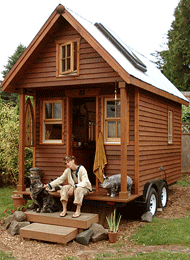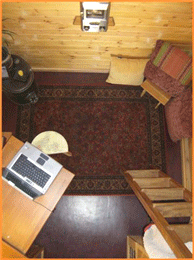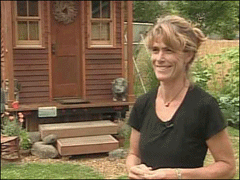Tiny House
Air Date: Week of May 22, 2009

Dee Williams sits on the porch of her dream house.
Dee Williams lives small, really small. Her 84 square foot home sits on wheels in a friend’s backyard. She has no running water or electricity, and uses a compost toilet. Williams tells host Steve Curwood about downsizing to reduce her carbon footprint and increase her community involvement.
Transcript
CURWOOD: Dee Williams lives in a tiny house. It’s just 84 square feet. She designed its layout on an area rug in the dining room of her previous home, a three-bedroom house in Portland, Oregon.
Her new house is on wheels but it is generally parked in a friend’s yard. She says she wanted to engage more in her community and reduce her carbon footprint. She’s also reduced her monthly expenses from fifteen hundred dollars to about five dollars – the costs of propane to cook and heat her new home.
Dee, now you were living in a nice bungalow when you decided to pack it all away and drastically downsize. Why?
WILLIAMS: Well I think a part of it was just wanting to do an experiment on myself. I had taken a trip to Guatemala and on that trip, you know, it was like a big spanking, you know. I bumped into all these folks in Guatemala who were just incredibly generous and had absolutely nothing. It was kind of this comparison thing that kinda brought home with me and then also, you know, just kind of taking a look at my world and realizing that our mortality is a real thing and if I did want to shake it up, I needed to do that.
CURWOOD: So I’m wondering if you can take me for a virtual tour of your home. Here I am standing in front of it. What do I see and what would happen if I walked through the front door?
WILLIAMS: Well, my little house looks like a little cabin, so its got a pointy little roof, a very small door – it’s like two feet wide. I pulled that out of a dumpster and it’s gorgeous. And a little front porch. And there’s a sleeping loft above the front porch so that kind of creates this little nook of the front porch. Walk inside – after you take your shoes off – and turn to the left: there’s the kitchen counter. And I have a crock that I carry water into the house and there’s a sink that drains into a jug under it. If you turn to the right, there’s a toilet and where I keep all my booboo dust.
CURWOOD: Booboo dust?
WILLIAMS: Booboo dust. In the Pacific Northwest those are cosmetics.
CURWOOD: Oh excuse moi.
[LAUGHING]
WILLIAMS: So you take a couple of steps and you’re out from underneath the sleeping loft. And you’re standing in this – what I call the great room. Its about a six by six foot space and has an eleven foot ceiling with a big skylight, and that’s my living room. I would make you crawl up into the sleeping loft to try it out because its incredibly spacious even though you can’t stand up there. There’s another skylight that’s over the bed, which is just an incredible gift, I mean, there’s nothing like being able to fall asleep staring at the stars or the moon or watching it rain.

A view from the sleeping loft of the great room. (Courtesy of Dee Williams)
WILLIAMS: It’s just the footprint of the bottom. I guess the rule of thumb for architects is that if you can’t stand up in a space, you don’t have to count it. So I think if I was to pull a real estate ad it would be one bedroom with a bonus room. I would be like a quarter bath or something like that because [laughing] I just have a toilet. I don’t have a sink.
CURWOOD: Talk to me about exactly how you built this. You have obviously some building skills yourself, you have some carpentry skills. As I understand it you got some shingles from a friend who stored them long ago, but where’d you get your other stuff?
WILLIAMS: I scavenged a lot of stuff out of debris piles, so the roof of the porch, the overhangs, the soffits, all of that is salvaged. The skylights came from a salvage yard. The kitchen counter is an old pocket door, the wood that’s on the walls, it’s knotty pine – that came from a habitat restore and the loft flooring came out of a house fire. It’s like the house kinda grew out of what was made available. It’s kinda cool to be able to live in a space that tells more of a story than I went to Home Depot and I got a great price on this.

Dee Williams.
WILLIAMS: I have a composting toilet. So I’ve got these new chores that are a part of living in an 84 square foot house. Managing my compost is one of them. Dragging water into the house for washing dishes and stuff like that is another chore.
CURWOOD: Okay Dee. How does one scale down from a three-bedroom house to something that is, you know, twelve by seven essentially?
WILLIAMS: I had to do it the hard way. I had to go through everything. [Laughing] I had like three piles: one pile was the stuff that was definitely gonna get dragged out to the curb and it was massive, it was like, you know, the moldy old ice cube trays and saggy futons and, you know, linens and garden tools. I got rid of all of that stuff. And it was pretty easy. I haven’t wondered, you know, “Gosh, you know, I wish I still had all of that silverware that didn’t match that I’ve been dragging around since college. That stuff was great.”
[LAUGHING]
CURWOOD: Okay, so – threw stuff out – and then?
WILLIAMS: And then, you know, I was left with the stuff that was just overwhelming to try to figure out. You know, the old love letters, trophies. So I put those in four of those – you know those plastic kinda of bins? Over the years I’ve gotten it down to about a fourth of one.
CURWOOD: Okay, well what about going forward – Dee, I mean every day there’s stuff that we encounter that we think we need to have – what do you do with that?

CURWOOD: [laughing] Okay.
WILLIAMS: It’s been a really good lesson for me to learn how to accept people’s gifts and my friends have been wonderful at teaching me that.
CURWOOD: So, at what point do you think you might decide you don’t want to live in this small space anymore – or maybe decide that you want to downsize even further?
WILLIAMS: You know I have thought about downsizing even further only because there’s a lot of wasted space. And then more recently I’ve thought that’s foolish.
[Laughing] I’ll go nuts. I need at least 84 square feet.
[LAUGHING]
WILLIAMS: And then as far as, you know, moving on to something else, I think if I, you know, fell in love and decided I wanted to be with somebody over a longer period of time than a few nights, I would definitely need more space and I would like to think that I could take the stuff that I’ve learned in this giant experiment in the backyard and apply that to whatever living situation I have.
CURWOOD: Dee Williams lives in Olympia Washington – well, at least that’s when her tiny home is parked there. Thanks so much, Dee.
WILLIAMS: Thank you so much.
[MUSIC]
CURWOOD: To hear much more of our interview with Dee Williams, and to see pictures of her tiny home, go to our website: loe.org.
[MUSIC: Various Artists “ Our House” from Pickin On Crosby, Stills, Nash & Young Vol. 2 (CMH Records 2002)]
Links
Living on Earth wants to hear from you!
Living on Earth
62 Calef Highway, Suite 212
Lee, NH 03861
Telephone: 617-287-4121
E-mail: comments@loe.org
Newsletter [Click here]
Donate to Living on Earth!
Living on Earth is an independent media program and relies entirely on contributions from listeners and institutions supporting public service. Please donate now to preserve an independent environmental voice.
NewsletterLiving on Earth offers a weekly delivery of the show's rundown to your mailbox. Sign up for our newsletter today!
 Sailors For The Sea: Be the change you want to sea.
Sailors For The Sea: Be the change you want to sea.
 The Grantham Foundation for the Protection of the Environment: Committed to protecting and improving the health of the global environment.
The Grantham Foundation for the Protection of the Environment: Committed to protecting and improving the health of the global environment.
 Contribute to Living on Earth and receive, as our gift to you, an archival print of one of Mark Seth Lender's extraordinary wildlife photographs. Follow the link to see Mark's current collection of photographs.
Contribute to Living on Earth and receive, as our gift to you, an archival print of one of Mark Seth Lender's extraordinary wildlife photographs. Follow the link to see Mark's current collection of photographs.
 Buy a signed copy of Mark Seth Lender's book Smeagull the Seagull & support Living on Earth
Buy a signed copy of Mark Seth Lender's book Smeagull the Seagull & support Living on Earth

